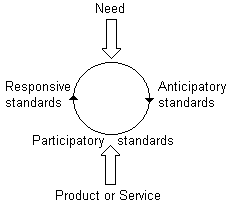| 2002 |
|---|
| Reference |
IEEE Definition |
Definition/
Use |
IEEE standards are classified as
- Standards: documents with mandatory requirements.(Mandatory requirements are generallycharacterized by use of the verb "shall," whereas recommended practices normally use the word "should." See the IEEE Standards Style Manual for further information.)
- Recommended practices: documents in which procedures and positions preferred by the IEEE are presented.
- Guides: documents in which alternative approaches to good practice are suggested but no clear-cut recommendations are made.
- Trial-Use documents: publications that are effective for not more than two years. They can be any of the categories of standards publications listed above.
An IEEE Standards Project may develop a document that is
- New: A document that does not replace or substantially modify another standard.
- Revision: A document that updates or replaces an existing IEEE standard in its entirety.
- Amendment: A document that has to contain new material to an existing IEEE standard and that may contain substantive corrections to that standard as well.
- Corrigenda: A document that only contains substantive corrections to an existing IEEE standard.
|
| 1999 |
|---|
| Reference |
/Wende, 1999/ Experiences and Positions of the DIN IT Standards Committee
|
Definition/
Use |
The German classification for standards:
- Specification: Is a detailed technical description, suitable for the implementation of a product or service.
- De facto: Is a specification which has gained broad acceptance in the market.
- Norm: Is a specification, worked out in a standards committee according to its consensus-based rules and passed through the five stage standardisation process including public inquiry.
|
| 1999 |
|---|
| Reference |
/Sherif, 1999/ Contribution Towards a Theory of Standardization in Telecommunications
|
Definition/
Use |
The figure below shows the position of the standard in the lifecycle
- Anticipatory standards: proceed in lock-step with implementations that test the specifications before adopting them. This incidental benefit can be an important factor in spurring innovation.
- Participatory standards: proceed in lock-step with implementations that test the specifications before adopting them.
- Responsive standards: occur to codify a product or service that has been sold with some success. When a stand-alone product is well entrenched there may be no incentive to standardise.

Responsive standards mean however, that the initial manufacturer will have to contribute to the standards development, in addition to developing the product. They may have to release technical information earlier than anticipated or modify future product plans. In addition, product differentiation will have to shift to areas not covered by the standard and requires more agility to response quickly to market needs. Should the choice of supporting a responsive standard be made, the initial manufacturer has to: 1) Achieve the maximum market penetration before differentiate the product based on quality, customer support, or services.
|
| 1995 |
|---|
| Reference |
/Moreton, 1995/ Implementing Information Management and Technology Standards: A Framework
|
Definition/
Use |
- Closed: This is a standard that is only used by specific organisations, not available widely and access to it is restricted to a small user base.
- Proprietary: This is a standard restricted mainly by the owner of the defining document or design. This is typically the type of standard sold by computer manufacturers who want to tie users into a specific product path.
- De facto: This is the type of standard that has achieved a wider user base and has become the pervasive standard by virtue of its use but is not supported by international standardisation activity.
- De jure: These standards are those supported by the work of the international standardisation bodies. This does not presuppose any actual use of the standard but only its derivation.
- Open: An standard is one that has arisen in any way and is available to all interested users on equal terms without significant restriction.
- Consortium: This is derived from a different route than the others and each particular consortium standard could be regarded as falling into any of the five categories by virtue of its use and availability.
|

 Identification
Identification Definitions/Uses
Definitions/Uses See also
See also GDPA Online
GDPA Online
 Last Updated 17.Apr.2002
Last Updated 17.Apr.2002
 Updated by Webmaster
Updated by Webmaster
 Last Revised 17.Apr.2002
Last Revised 17.Apr.2002
 Revised by Webmaster
Revised by Webmaster

